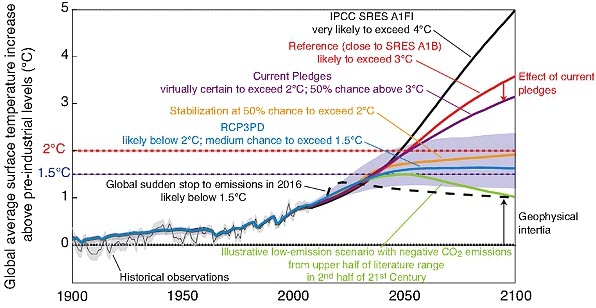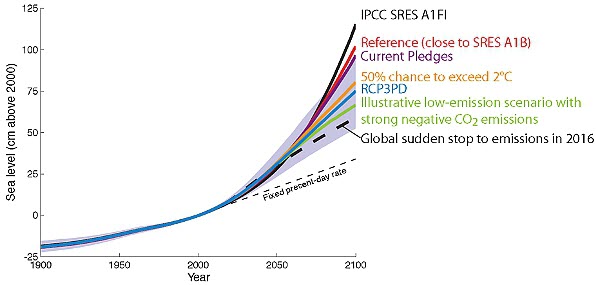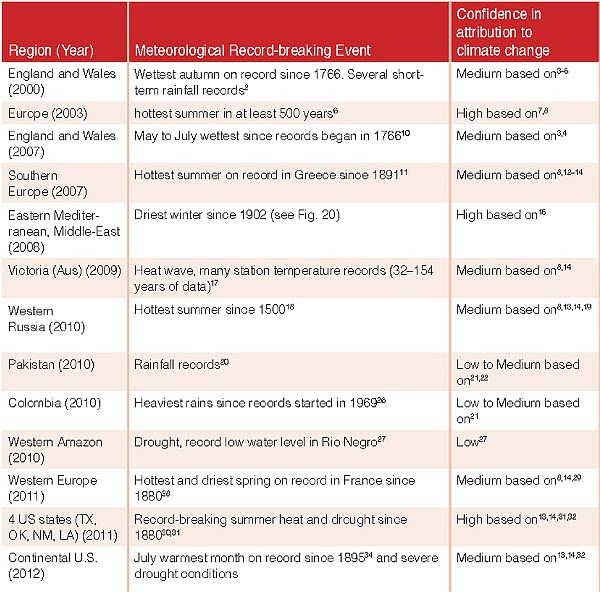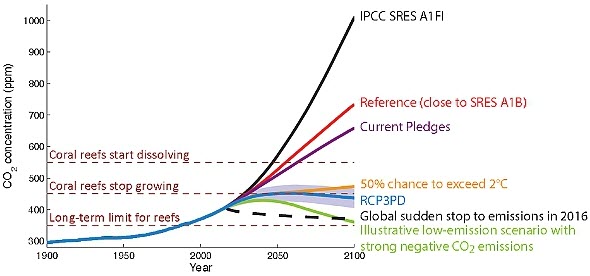The World Bank yesterday released a report prepared by the Potsdam Institute spelling out what the world is likely to experience if it warmed by 4 degrees — that’s looking increasingly likely by the end of the century without some serious policy changes by governments globally.
The report essentially attempts to summarise much of the research literature that has built up since the 2007 fourth IPCC Assessment Report and puts it in the context of the path we’re on unless we start taking this problem seriously. It doesn’t make for pleasant reading. World Bank President Dr Jim Yong Kim says “it is my hope that this report shocks us into action”, as he believes “a 4 degree world can, and must, be avoided”.
For the World Bank, with a primary purpose to help impoverished nations out of poverty, “the lack of action on climate change not only risks putting prosperity out of reach of millions of people in the developing world, it threatens to roll back decades of sustainable development”.
The chart below provides an impression of the alternative emission paths and their likely implications for temperature rise. According to the report, we are on a path illustrated by the red line. However, if governments follow through on the pledges they’ve made at the UN’s Copenhagen and Cancun summits then it would put us on the purple line, giving a mean temperature rise estimate of 3 degrees.
But even this path still carries a 20% chance of temperature exceeding 4 degrees. If governments don’t make good on their pledges then the red line would imply a 40% chance of warming above 4 degrees.
Median estimates of temperature rise from probabilistic projections for several scenarios

The latest research, unlike older assessments, is more confident that land-based ice, and not just thermal expansion of existing sea water, will play a significant role in sea level rise. Older assessments were hopeful that increased snow falls might occur over Greenland and the Antarctic that could offset any melting from higher temperature. Unfortunately, the rate of land ice contribution to sea level rise has increased by about a factor of three since the 1972–1992 period. And both the Greenland and Antarctic ice sheets have been losing mass since at least since the early ’90s.
The chart below illustrates that our current emissions path (the red line) gives a mean estimate of a one metre rise in sea level by the end of this century. However, sea level would continue to rise substantially after this point. For example, even if global warming was limited to 2 degrees, global mean sea level could still rise by between 1.5 and 4 metres above present-day levels by the year 2300.
Probablistic projections of sea level rise for different emission scenarios

Rising temperatures will lead to increased likelihood of extreme weather events and heat waves. The report notes that the past decade has seen an exceptional number of extreme heat waves around the world. These events — Victoria’s 2009 heat wave and associated severe bushfire; Russia in 2010 (which claimed 55,000 lives); Europe in 2003 (70,000 premature deaths); the US in 2012 — were highly unusual with monthly and seasonal temperatures typically more than three standard deviations warmer than the local mean temperature for that period.
Another well understood feature of this warming will be a strengthening of the hydrological cycle because a warmer atmosphere can hold more water vapour. This tends to exacerbate droughts and flooding rains.
The table detailed below documents a series of extreme events over the past decade and the degree of confidence that these could be attributed to human-induced climate change. Many of these events are so outside the bounds of past experience that it seems there is a medium to high likelihood that global warming has contributed to the event’s severity.

Note: numbered references available from page 18 of the report
These extreme events, in conjunction with rising overall temperature, will take their toll on agriculture. While modelling prior to 2007 predicted some improvement in food production with warming of 1 to 3 degrees, according to the analysis, “research since 2007 is much less optimistic”. The report observes:
“These new results and observations indicate a significant risk of high-temperature thresholds being crossed that could substantially undermine food security globally in a 4°C world.”
The effect of 4 degree warming would be disastrous for coral reefs. Coral reefs would stop growing at a CO2 concentration of about 450ppm, which we’re well on the way to hitting within the next few decades. And coral reefs are at high risk of dissolving by around 2050 unless we seriously turn our emissions growth around.

Those who aren’t inclined towards conspiracy theories already know this is a serious problem. This report simply provides an exclamation point on the already apparent urgent need for action.
*This article was originally published at Climate Spectator







Given geological evidence of coral reefs thriving at CO2 concentrations far in excess of 450 ppm, “coral reefs would stop growing at a CO2 concentration of about 450ppm” is probably an oversimplification. While currently dominant coral species begin to labour under these conditions, it’s certain that other, better adapted species currently restricted to niches will come to the fore. Reef systems as a whole will thus be maintained – if (and yes, it’s a biggie) there is enough time for the system adaptation to occur.
Mark, I would prefer not to watch whole suites of species go extinct and wait for development of new ecosystems, just because we are too lazy and selfish to act.
If it was war, who would argue about the personal sacrifice and action required or associated costs. However the potential outcomes look far worse than any war – a habitable planet.
“It doesn’t make for pleasant reading.”
Fortunately it doesn’t make credible reading either: the so-called research is just a rehash of dated and largely discredited IPCC material: The Himalayan glaciers are not melting, nor are the ice-caps on Greenland or Antarctica, and the Antarctic sea ice continues to grow: the exact opposite of what the IPCC models predicted. Polite Peer review articles say “the Antarctic ice spread has the effect of limiting confidence in the models’ predictions”. That means the World Bank is pontificating on outdated conclusions: What runaway warming?
Al, your claims should read “a few Himalayan glaciers are not melting, though most are, the ice caps on Greenland are melting faster than anticipated, the Antarctic sea ice is growing to a small degree with normal bounds, as expected, but the overall sea ice is shrinking dramatically. Overall, the global cryosphere is shrinking faster than expected”. Your statement is either wrong, or leaving out that you are looking at a few cherries amongst the global melt.
Al Black: pray tell what is your source for the “largely discredited IPCC material”? BTW, no one is talking about “runaway warming”. That reads suspiciously like a “straw man” argument to me.